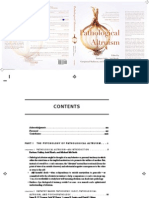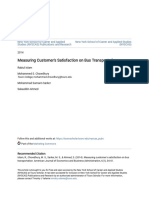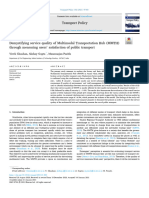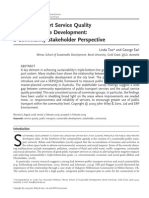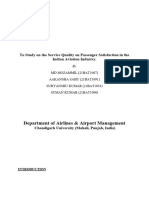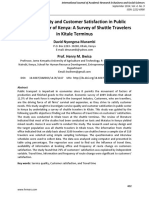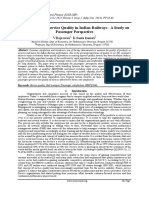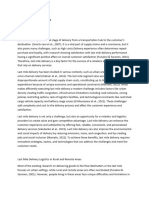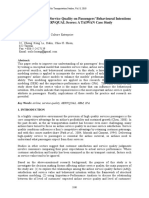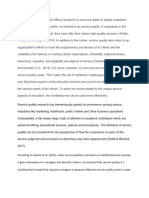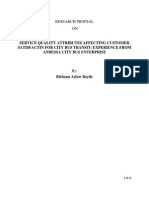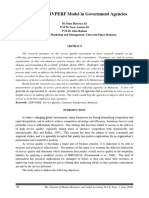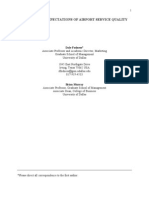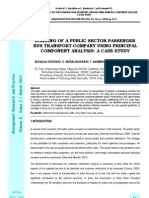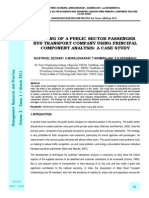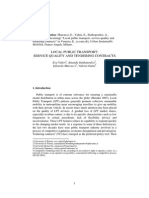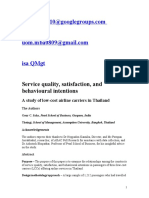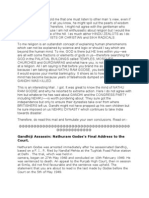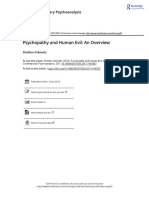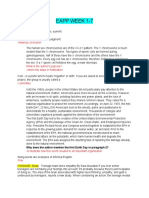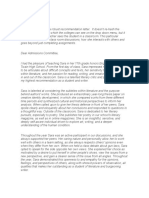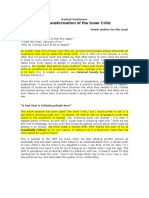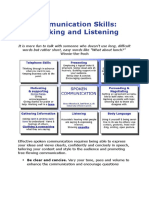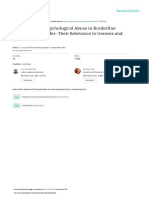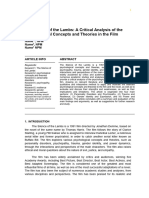Measuring Commuters' Perception On Service Quality Using SERVQUAL in Public Transportation
Measuring Commuters' Perception On Service Quality Using SERVQUAL in Public Transportation
Uploaded by
Krishna JainishCopyright:
Available Formats
Measuring Commuters' Perception On Service Quality Using SERVQUAL in Public Transportation
Measuring Commuters' Perception On Service Quality Using SERVQUAL in Public Transportation
Uploaded by
Krishna JainishOriginal Description:
Original Title
Copyright
Available Formats
Share this document
Did you find this document useful?
Is this content inappropriate?
Copyright:
Available Formats
Measuring Commuters' Perception On Service Quality Using SERVQUAL in Public Transportation
Measuring Commuters' Perception On Service Quality Using SERVQUAL in Public Transportation
Uploaded by
Krishna JainishCopyright:
Available Formats
www.ccsenet.
org/ijms
International Journal of Marketing Studies
Vol. 3, No. 1; February 2011
Measuring Commuters Perception on Service Quality Using SERVQUAL in Public Transportation
Kokku Randheer Assistant Professor, Department of Marketing, College of Business Administration (CBA) Ministry of Higher Education, King Saud University (KSU) P.O.Box 2459, Riyadh 11451, Kingdom of Saudi Arabia Tel: 96-055-368-1946 E-mail: krandheer@hotmail.com; rkokku@ksu.edu.sa Ahmed A. AL-Motawa Chairman of Department of Marketing, College of Business Administration (CBA) Ministry of Higher Education, King Saud University (KSU) P.O.Box 2459, Riyadh 11451, Kingdom of Saudi Arabia Tel: 96-050-674-5550 E-mail: amotawa@yahoo.com; amotawa@ksu.edu.sa Prince Vijay. J Doctoral Research Scholar in Management at ICFAI University, Tripura INC Research Staff College, Plot No.63 Nagarjuna Hills, Panjagutta, Hyderabad 500 082, India Tel: 929-312-6856 Abstract In the current scenario of globalization, public transportation services (PTS) need to introspect sensitivity towards the quality of services offered. In this context, this study examined the commuters perception on service quality offered by the public transport services of twin cities of Hyderabad and Secunderabad, India. The SERVQUAL scale is administered to measure the commuters perception on service quality. A survey was conducted among the commuters who were regularly availing public transport services for travelling. A random sample of 534 respondents were taken for data collection, among them 512 were finalized for final analysis. The study concluded that the service quality delivery meets the perception of commuters. In general, people of twin cities of Hyderabad and Secunderabad are benefited with the service quality delivery by public transport services. This paper brings out a service quality image which can be adopted by other cities whose population depends on public transportation services. Keywords: Public transportation services, Service quality, Commuters perception, SERVQUAL 1. Introduction Service quality is generally visualized as the sum of customer perceptions of the service experience (Johns, 1992). The difference between service quality and satisfaction is perceived service quality is a global judgment, or attitude, relating to the superiority of the service. Whereas satisfaction is related to the specific transaction (Parasuraman, Valarie, Zeithaml & Berry, 1988). Customers form service expectations from many sources, such as past experiences, word of mouth, and advertising. In general, customers compare the perceived services with the expected service (Voss, Parasuraman & Grewal, 1998). If the perceived service falls below the expected service, customers are dissatisfied and if the perceived service quality is above the expected level, it creates satisfied customers (Andreassen, 1995). Marketers need to understand that customers are more than mere consumers of service quality output; they are co-producers of the quality process (Gronroos & Ojasalo, 2004). According to Berry, Parasuraman and Zeithaml (1988) service quality has become a significant differentiator and the most powerful competitive weapon (Clow & Vorhies, 1993), which many service organizations possess. E-mail: prince.vijai.j@gmail.com
Published by Canadian Center of Science and Education
21
www.ccsenet.org/ijms
International Journal of Marketing Studies
Vol. 3, No. 1; February 2011
Successful companies add benefits to their offering that not only satisfy customers but surprise and delight. Delighting the customers is a matter of exceeding expectations (Rust & Oliver, 2002). Public transportation is defined as transportation by a conveyance that provides continuing general or special transportation to the public; excluding school buses, charter and sightseeing service. Public transportation includes various modes such as buses, sub ways, rail, trolleys and ferry boats (Tran & Kleiner, 2005). Public sector organizations including transportation services are created by governments with an intention not to compete in the open market, rather their objective is to fulfill the needs of common public. As public transport organizations grow older and matured, the quality of service dwindles down with public being left with no option but to accept what is offered (Andreassen, 1994). To help this situation the concept of quality need to be introduced into public transportation for meeting the quality expectations of the public (Ancarani & Capaldo, 2001). Management of public transportation have to take focused initiatives such as carrot and stick policy for the managerial cadre to perform better and encourage them with autonomy to act (Brysland & Curry, 2001). Competitive advantage benefits customers and service quality is one of the mechanisms to achieve this (Clow & Vorhies, 1993). Service quality is recognized as one of the important areas on which public organizations including transportation services are focusing in present times (Ancarani & Capaldo, 2001). Hood (1995) in his research has revealed dimensions which lead to better quality in public services such as better experience management, adopting corporate style of functioning, bench marking activities, competitive based work environment, optimization and better planning of organizational resources, more focus on service quality output generation. Though service quality is an important aspect in public transportation, there is very less research being done to explore this issue (Friman, Edvardsson, and Garling, 2001). Hence to a large extent its a virgin area to investigate. Today people from across India and other parts of the world have formed a major potential work force in twin cities of Hyderabad and Secunderabad. The most convenient and cheapest travel is public transportation services. Every day 3.8 million people travel through public transportation services (www.apsrtc). In such a scenario, systematic research aimed at measuring the commuters perception on service quality offered by the public transport services will be beneficial to consumers and service producers. In his study Andreassen (1995) opined a similar objective of public transportation achieving satisfaction which meets public expectation. The present study focused on the following objective, to measure and assess the level and significance of service quality perception of the commuters on SERVQUAL scale given by Parasuraman et al (1988) additionally including cultural dimension. 2. Literature Review Research on service quality has been done from various aspects from a very long time, sufficient research has been contributed by (Gronroos, 1982; Berry, Zeithaml, & Parasuraman, 1985; Parasuraman, Zeithaml, & Berry,1985; Zeithaml, Parasuraman, & Berry, 1985; Brady & Cronin, 2001) in developing the service quality concept. There is a need for conceptual changes to be built as the present concept of service quality does not fit the multidimensional situations across nations. (Cronin and Taylor, 1992; Brady and Cronin, 2001) in their study argued that there is a need to address multidimensional aspect of service quality. The issue of measuring service quality across several service sectors has been explored by researchers like (Parasuraman et al, 1985; Parasuraman, Berry, & Zeithaml, 1991; Koelemeijer, 1991; Cronin & Taylor, 1992; Vandamme & Leunis, 1993; Parasuraman, Zeithaml, & Malhotra, 2005). Though SERVQUAL as a measurement tool used in numerous studies, it was tailored to fit a particular sector and context, like E-S-QUAL for electronic sector and SERVPERF for service preference. Hence there is a scope for SERVQUAL to be further modified for universal standardization (Parasuraman et al, 1991). The issue of improving service quality where by organization can derive competitive advantage has been investigated by (Reicheld and Sasser, 1990; Berry, Zeithaml, & Parasuraman, 1990; Hensel, 1990; Berry, Parasuraman, & Zeithaml, 1994; Berry & Parasuraman, 1997; Glynn & Brannick, 1998; Johnston & Heineke, 1998; Harvey, 1998). Service quality has been used as an ingredient in understanding consumer behaviour. A positive consumer behaviour on service quality will lead to higher returns (Zahorik & Rust 1992; Boulding, Kalra, Staelin, & Zeithaml, 1993; Zeithaml, Berry, & Parasuraman, 1996; Liu, Sudharshan, & Hamer, 2000). The framework for measuring service quality in public transportation ref figure 1, envisages the generic dimensions tangibility, reliability, responsiveness, assurance and empathy given by (Parasuraman et al, 1988) model for measuring service quality. Population specific characteristics and public transportation specific determinants influence the generic dimensions. Hence the construct of service quality measurement is modified to suit the present study context, Svensson (2004) in his study has laid the importance of customizing a particular model to match the study context.
22
ISSN 1918-719X
E-ISSN 1918-7203
www.ccsenet.org/ijms
International Journal of Marketing Studies
Vol. 3, No. 1; February 2011
Service quality in public transportation system constitutes of internal and external factors which affect the commuters perception towards the public transport services (Middleton, 1998a). Internal factors such as strategic issues (Lee, Lee, & Lee,2006), top management commitment, service quality standards (Middleton, 1998b), monitoring systems (Deegan, 2002; Gray, 2002; Alexandre & Short, Dec 1995/Jan 1996), customer complaints handling system (Kotler & Kavin, 2008) and external factors such as alternative services (e.g. private services[1], auto-rickshaws[2], own vehicles) (Evans & Shaw, 2001; Michel, 1999), frequency of traveling and timings(Flem & Schiermeyer, 1997; Galetzka, Gelders, Verckens, & Seydel, 2008) convenience and comfort (Regis, 1996), climate, ego, social status, professions(Sanchez, 1999). The possibility of demographic character based customer ratings of service performance can also be measured. Lim, Bennett, and Dagger, (2008) have identified the importance of demographic characteristics in measuring service quality. Demographic characteristics such as age (Kumar & Lim, 2008), income, education etc can be taken into consideration to measure the service quality and can receive different service performance ratings. However, the bias seems to diminish when service fairness is considered. It appears that customer perceptions with regard to demographic characteristics are more powerful and important determinants of overall satisfaction. Customers expect justice in regards to fair service delivery. Interestingly, significance appears to exist between the opinions of customers across various demographical characteristics for service fairness (Snipes, Thomson, & Oswald, 2006). Service quality is also influenced by local or national culture of a particular country. Karen and Boo (2007) in their research have appealed to the researchers to add cultural dimension to service quality studies as the traditional SERVQUAL dimensions may not be meaningful in all situations and contexts. Culture is the epicenter of a society. It guides the way people live, think, behave, perceive things, and build attitudes. Plethora of research has been done on culture being a dimension having a significant effect on consumer behaviour with regards to service consumption (Mattial, 1999). Winsted (1997) had investigated dimensions related to behavior of American and Japanese service consumption. In comparison to these both countries, Americans preferred quality, delivery and cooperativeness, Japanese preferred coordination and customization. Cross-cultural consumer behaviour shows exhibition of different attitudes, countries which are developing like India, where consumers are low on registering complain, since they are not exposed to higher quality in any walk of their life. Countries which are developed like USA, where high quality is the order of life, consumers wont compromise on quality issues, they tend fast towards complaining. Liu and McClure (2001) focused their research in studying cultural differences in consumer behaviour and found similar outcomes. Malhotra, Ulgado, Agarwal, and Baalbaki, (1994); Malhotra, Ulgado, Agarwal, Shainesh, and Wu, (2005) has proved that there is a difference of perception on service quality among customers in developing and developed nations, they have identified ten factors related to social, cultural and economic environment which play role on customers assessment of service quality perception. The pioneering study done by Hofstede (1991) in which he had studied about national cultures in line with four service quality dimensions of competence, communication, credibility and courtesy. The study also took into consideration two cultural dimensions as power distance among organizations and presence of individualism or collectivism in the society. Data was collected from a large sample of above one hundred thousand employees of IBM across seventy two countries, twenty languages and duration was from 1967 to 1973. Paul and Alain (1996) have tried to explore the culture issue of service quality. They assessed the service quality using SERVQUAL on ten variables: reliability, responsiveness, competence, access, courtesy, communication, credibility, security, understanding/knowing the customer, and tangibles. The study was conducted to compare the service quality among customers of border areas of Mexico and America. They have found significant differences existing among customers of Mexico and America in relation to service quality. Five dimensions as suggested by the researchers were taken for the study as tangibility, reliability, responsiveness, assurance and empathy. In a particular study Kang and James (2004) have identified that the five dimensions of SERVQUAL are important for measuring the service quality delivery. Using these generic dimensions the service quality scale developed by (Parasuraman et al., 1988) was modified to suit to the present study subject by adding sixth dimension as culture. Collectivism identified by (Hofstede, 1991) was considered as a cultural aspect for this study, collectivism highlights the importance and respect of overall group behaviour rather than individual. The group exhibits integrity in collectivistic values which influence the service design and service delivery. A study done by Rugimbana (2007) in Malaysia on youth revealed that young population(collective) has three individual groups Chinese(Confucius), Indian and local Malya. He found that there was significant influence of collective values in the adoption banking services. The potential application of SERVQUAL scale is, it can help a wide range of service organizations in assessing perceptions of service quality (Buttle, 1996). It can also help in identifying areas requiring managerial attention and action to improve service quality (Kettinger & Lee, 1997). Managerial implication given by Kang, James, and Alexandris, (2002) reveals that SERVQUL will enable
Published by Canadian Center of Science and Education 23
www.ccsenet.org/ijms
International Journal of Marketing Studies
Vol. 3, No. 1; February 2011
managers to measure the internal service quality and external service quality, so as employees understand their role in delivering quality to customers. In addition, the availability of this instrument will stimulate much-needed empirical research focusing on service quality and its antecedents and consequences. 3. Research Methodology Initial instrument was developed by generating 28 items after a thorough understanding of conceptualization and operationalization of the service quality construct in public transportation services in twin cities of Hyderabad and Secunderabad. The SERVQUAL developed by (Parasuraman et al., 1988) was adopted to prepare the initial instrument, with the help of two public relations officers of public transport operating corporation. The first part of the questionnaire was left with four items relating to tangibility factor, second part with five items relating to reliability factor, third part with four items relating to responsiveness factor, fourth part with four items relating to assurance factor, fifth part with five items relating to empathy factor and sixth, the last factor with six items relating to cultural factor. All the closed-ended questions were designed to generate responses on a five point Likert scale to measure the perception of service quality indicated as -1 strongly disagree, -2 disagree, 0 neither or nor, +1 agree and +2 strongly agree. Cui, Lewis, and Park, (2003) in a study measuring service quality using SERVQUAL with five dimensions have achieved successful results using likert scale with seven point scale, however for the present study five point likert scale is used since respondents are intercepted at bus points(bus stations), hence to reduce the time of response and make respondent more comfortable. A study done by Perez, Abad, Carrillo, and Fernandez, (2007) has used five point scale in knowing the commuters behaviour about public transportation services in Spain. This measurement scale was developed, as suggested by (Stafford, 1999; Akan, 1995) that SERVQUAL need to be modified to suit to a particular industry context. Hence in the present study culture as sixth dimension has been added ref figure 2. Quantum of research in SERVQUAL is done, and in many research studies it is established that the generic SERQUAL scale has to be extended with new dimensions, (Boulding et al., 1993; Cronin & Taylor, 1992; Parasuraman et al., 1991;2005; Zeithaml et al., 1996). Majorly the SERVQUAL model has been used tested and enhanced within the United States. In India few studies have been conducted by (Malhotra et al., 2005; Satyabhusan, Ed, & Kalyan, 2009). For the present study a pilot study was initiated with a sample of 45 respondents which resulted in the elimination of two items leaving 26 items spread across five service quality dimensions : tangibility three items, reliability three items, responsiveness five items, assurance five items, empathy five items and culture five items. A sample size of 534 was taken to meets the sample adequacy, for conducting factor analysis number of statements multiplied by ten (26 statements * 10 = 260) is minimum required sample size, this study had considered double the minimum required size. The period of the study was 1st February to 3rd of March, 2010. The sample respondents for the study were selected from the population by convenient sampling method because of easy accessibility and affordability. Yu, Hong, Gu, and Wang, (2008) has used this method of sampling in a study relating to people opinion on public library system. This study is limited to a particular public operation service provider and none of the private players were taken into consideration. Survey method was used for collecting primary data at select bus stops from the commuters who regularly travel through public transportation. The period of data collection was for 4 consecutive weeks from Monday to Friday during evening time (5.00 8.00 p.m.) in twin cities of Hyderabad and Secunderabad. 512 completely completely filled in questionnaires were finalized, non response rate was negligible. Adequate care has been taken to avoid redundancy in data collection from the sample elements. 4. Data Analysis 4.1 Respondents Profile Out of the complete questionnaires filled in 53.5% were males and 46.5% females. The percentage difference between male and female respondents is less; this is due to male-female population ratio in urban India being almost close. 37.2% of the respondents were in less than 25 age group, 34.6% were between 26-35 age groups, 17.4% were between 36-45 age group and 10.8% were above 45 age group. The percentage of first group, that is less than 25 age and second group between 26-35 age amounts to 71.8%, which is due to higher percentage of younger population in India. 65.8% have responded that they were unmarried and 34.2% were married. The high percentage of unmarried respondents is due to the average marriage age in urban India is between 30-32, since it takes longer years for a male and females to economically settle down. With regards to educational qualifications 64.5% reported to be post-graduates, 28.3% to be graduates and 7.2% being other qualification. In India, the education of children is financially and morally supported by their respective parents, added to it, the social stigma is higher education-higher social status; hence finding more post-graduates in urban India is the deal. In terms of employment status 44.3% were professionals, 39.7% were
24
ISSN 1918-719X
E-ISSN 1918-7203
www.ccsenet.org/ijms
International Journal of Marketing Studies
Vol. 3, No. 1; February 2011
students, 9.1% were wage employees, 4.6% were self-employed and 2.3% were others. This indicates that majority of the respondents are engaged in professional work, India is one of the countries producing more number of Engineers, Doctors, MBAs, MCAs, and other Masters programs. 62.7% of the respondents reported they were using from last 2 to 5 years, 21.4% were using for more than 5 years and 15.9% where using from less than 2 years. The travelling distance (distance of travel each day using public transport services), 37.9% respondents were traveling between 16 - 20 kilometers[3] per day, 30.9% were traveling 11 -15 kilometers per day, 19.4% of the respondents were traveling more than 20 kilometers per day, 8.2% were traveling between 5 - 10 kilometers per day and 3.6% were traveling less than 5 kilometers. 57.3%(37.9% + 19.4) of respondents were travelling a distance 16 to 20 and upward, this trend is true, fast urbanization growth in India and expansion of cities to bigger scale is the reason for people to travel large distances majorly for employment purpose and other reasons. 4.2 Factor Analysis Factor analysis was identified as tool to identify suitable dimensions and related items. Data was analyzed using principal component extraction with an orthogonal (varimax) rotation, a factor loading benchmark of 0.4 was used for validity. This criteria has eliminated tangibility ref figure 2 and retained other five factors with 23 items. Ten items have relocated in this study ref table 1, it shows that the item employees in PTS area consistently courteous with you relocated from dimension assurance to reliability. Similarly, the behavior of employees in PTS instills confidence in you, employees in PTS have the knowledge to answer your questions and PTS insists on error free records were relocated from assurance and reliability to responsiveness and respectively; PTS services are punctual, employees in PTS tell you exactly when services will be performed and employees in PTS give you prompt service, PTS has operating hours convenient to all its customers have relocated from reliability, responsiveness and empathy to assurance. PTSs employees are neat appearing and when you have a problem PTS shows a sincere interest in solving it relocated from tangibility and reliability to in the Indian situation. In a similar study on public transportation by (Perez et al., 2007) the results of factor analysis has relocated items among dimensions. The alpha coefficients of these five factors are 0.9332, 0.9012, 0.9142, 0.8994 and 0.9630 respectively (ref table 1). These results indicate that the four factors are reliable (Nunally, 1978). This supports the internal cohesiveness of the items forming each dimension. PTS gives attention to women, children and handicapped had relocated from empathy to culture. Hence the items prescribed in the SERVQUAL scale under each dimension developed by (Parasuraman et al., 1988) are not directly applicable 4.3 Validity The validity of the instrument was tested using correlation and regression analysis. The Pearson correlation coefficient between the overall service quality (OSQ) and the five dimensions of the instrument are shown in table 2. Table 2 shows that all coefficients are significant at the 0.001 level. This supports the validity of the instrument. Regression analysis was also conducted for the purpose of validity. The regression model has the following form: Totality f(Reliability; responsiveness; assurance; empathy; culture): The summary of the regression results are shown in table 3. It can be seen from the results provided in table 3 that the R-square is 0.716. This indicates that the five independent variables explain 71.6 percent of the variations in overall service quality. This R-square is significant at the 0.001 level. The resulting regression model is: Totality f( 0.102 + 0.241(reliability) + 0.202(responsiveness) + 0.247 (assurance) + 0.227(empathy) + 0.298(culture). Table 3 shows that the coefficients of the dimensions of reliability, responsiveness, assurance, empathy are significant at the 0.01 level, while the coefficient for culture is significant at the 0.05 level. This supports the validity of the questionnaire (Webb et al. 2000). This also stresses the importance of customizing measures of service quality to different contexts and countries. 5. Conclusion The aim of this study is measuring the commuter perception on service quality in public transportation using SERVQUAL, at the same time it also insists on the extension of generic SERVQUAL dimensions with additional dimension representing the study context. Culture as a new dimension was added (Paul and Alain,1996; Malhotra, Agarwal, & Peterson, 1996; Malhotra et al.,1994; Malhotra et al., 2005; Mattila, 1999; Winsted, 1997; Liu and McClure, 2001; Karen and Boo, 2007; Satyabhusan et al., 2009) have identified culture to be an important aspect in measuring service quality context. Public transportation is no exception, (Perez et al., 2007). In the initial phase of understanding the operational and strategic issues involved in running the public
Published by Canadian Center of Science and Education
25
www.ccsenet.org/ijms
International Journal of Marketing Studies
Vol. 3, No. 1; February 2011
transportation, researchers had taken the help of public relation officers of the transportation corporation, the session has thrown light on culture being a part of service design, hence its inclusion into the study was established. The thought process on the instrument development resulted in six dimensions and twenty eight items, a pilot study with forty five respondents resulted in the elimination of two items, bringing the item count to twenty six. Data is finalized from five hundred twelve questionnaires. Factor analysis was used to analyze the data resulting in the elimination of one dimension : tangibility and three items, further bringing down the item count to twenty three, this revealed that The remaining dimensions are reliable and valid. In several service quality measurement studies done by (Parasuraman et al., 1988; Parasuraman et al., 1991; Parasuraman et al., 2005; Sahu, 2006; Snipes et al., 2006; Stafford, 1999; Vandamme & Leunis, 1993; Yu et al., 2008) the scale refinement was done resulting in elimination of some items and dimensions. Based on the regression model, it was assessed that culture is one of the important dimension of service quality in public transportation. This exposes that measuring service quality using SERVQUAL need to be modified/extended under different study contexts. The personal and demographic profile of the commuters indicate that majority of the service users are professionals belonging to the middle aged; monthly income is reasonably well and travelling distance is moderate. Most of the commuters are using the service over a considerable number of years. As we compare the individual statements, employees willingness to help and behavior instilled confidence are given the highest preference, which is true in the twin cities context. Commuters often ask bus drivers to stop the bus for a while more at bus stops, most of the times commuters also expect the bus to stop in places other than bus stops, so as they avoid walking back from bus stop to office or home. The next set of statements receiving higher scores are timely promised services and convenient operating hours, as twin cities of Hyderabad and Secunderabad is densely populated, huge employee and student population is dependent on public transport services, as such reaching the office or college and back home at appropriate time needs buses to maintain time accuracy and also availability of buses at office start and finishing timings are very important. Since time factor is most important for commuters, they are interested in reaching the destination on time instead this may not be true for leisure travelling which is not a part of this study. The statements receiving next higher scores are in line with local values and attention to women, children and handicapped, the design of public transportation services in twin cities is done in line with local culture as women and children seats are reserved and they expect bus conductor to help them identify reserved seats for them. There are bus services dedicated only for women, they are called ladies special, This is very unique in itself. Women derive more respect in the local culture hence it has influence on service quality. As of, in most of the SERVQUAL studies done by (Akan, 1995; Brysland & Curry, 2001; Buttle, 1996; Cui et al., 2003; Parasuraman et al., 1988) tangibility was found to be the most important dimension, but this study reported it in reverse. Comparison of means of dimensions indicates that responsiveness assurance, reliability, culture and empathy form the order. The research reveals that the expectations of the commuters in terms of service quality are delivered by the public transport services. In this competitive global business environment, the consumer expectations are ever increasing, the service providers can meet the expectations only if they are sensitive to customer issues. Thus, the public transport service must understand the core responsibility of providing reliable services to the commuters consistently, which will yield better results in terms of service quality. 6. Societal Implications Public transportation can help all major urban cities decrease the level of pollution, since vehicular pollution is one of the major pollution contributor in urban areas, better service quality in public transportation can attract a large number of people to minimize the use of privately owned transport like car, bike or other vehicles. As better service quality in public transportation attracts more commuters it will address not only urban pollution, but also it will solve the traffic problem in most of the cities, hence public transportation can be used as one shot for two birds. 7. Scope for Further Research This study largely focused on SERVQUAL being the measurement tool for measuring the service quality. As such public transportation is an essential service in a large number of nations, hence a custom made scale measuring service quality can be developed. Culture was taken as part of this study and was not fully explored, since there can be other variables like values, ethos, individualism, language etc which tend to influence service quality, further research can be extended to fully exploit the cultural and related aspects. Further longitudinal studies can be done at regular time intervals over the years to reinforce the arguments. A comparative study can
26
ISSN 1918-719X
E-ISSN 1918-7203
www.ccsenet.org/ijms
International Journal of Marketing Studies
Vol. 3, No. 1; February 2011
be aimed between public and private operation services. Further it can be extended to semi-urban and rural area to obtain their perception too. 8.Value addition to the existing literature This study is first of its kind in measuring service quality in public transport services in India. A framework is carved for measuring the service quality in public transportation. As sighted in the study that in most of the SERVQUAL studies, tangibility was found to be most preferred dimension. The case is reverse in this study as tangibility was not the most preferred. The factor analysis shows that ten statements were inter-located within the dimensions, hence it proves the truthfulness that the SERVQUAL scale need to be modified to suit to a particular study situation as said by earlier researchers like (Stafford, 1999; Akan, 1995). This study has identified that there is a need and scope to develop a distinctive measurement scale to measure service quality in public transportation. Though in this study culture has not been explored to the fullest extent, future research can focus more in terms of culture. Acknowlegement We express our thanks to Professor. Abdulrahman Al-Aali, Department of Marketing, College of Business Administration, King Saud University, Saudi Arabia for giving us valuable insights in finalizing this paper. References Akan, P. (1995). Dimensions of service quality: a study in Istanbul. Managing Service Quality, 5(6), 3943. Alexandre, A., and Short, J. (Dec 1995/Jan 1996). Can pricing change urban travel?, Organization for Economic Cooperation and Development. The OECD Observer, 197, 20-21. Ancarani, A., and Capaldo, G. (2001). Management of standardised public services: a comprehensive approach to quality assessment. Managing Service Quality, 1(5), 331-41. Andreassen, T. W. (1994). Satisfaction, loyalty, reputation as indicators of customer orientation in the public sector. International Journal of Public Sector Management, 7(2), 16-34. Andreassen, T.W. (1995). (Dis)satisfaction with public services: the case of public transportation. Journal of Services Marketing, 9(5), 30-41. Berry, L., Zeithaml, V., and Parasuraman, A. (1985). Quality counts in services too. Business Horizons, May-June, 44-52. Berry, L.L., Parasuraman, A., and Zeithaml, V.A. (1988). The Service Quality Puzzle. Business Horizon, 31(5), 35-43. Berry, L., Zeithaml, V., and Parasuraman, A. (1990). Five imperatives for improving service quality. Sloan Management Review, 33, 29-38. Berry, L., Parasuraman, A., and Zeithaml, V. (1994). Improving service quality in America: lessons learned. Academy of Management Executive, 8, 32-52. Berry, L., and Parasuraman, A. (1997). Listening to the customer the concept of a service quality information system. Sloan Management Review, 38(3), 65-76. Boulding, W., Kalra, A., Staelin, R., and Zeithaml, V. (1993). A dynamic process model of service quality: from expectations to behavioral intentions. Journal of Marketing Research, 30, 7-27. Brady, M., and Cronin, J. (2001). Some new thoughts on conceptualising perceived service quality: a hierarchical approach. Journal of Marketing, 65(3), 34-49. Brysland, A., and Curry, A. (2001). Service improvements in public services using SERVQUAL. Managing Service Quality, 11(6), 389-401. Buttle, F. (1996). SERVQUAL: review, critique, research agenda. European Journal of Marketing, 30(1), 08-33. Clow, K., and Vorhies, D. (1993). Building a competitive advantage for service firms. Journal of Services Marketing, 7(1), 22-32. Cronin, J., and Taylor, S. (1992). Measuring service quality: a reexamination and extension. Journal of Marketing, 56, 55-68. Cui, C.C., Lewis, R.B., and Park, W. (2003). Service quality measurement Korea. International Journal of Bank Marketing, 21(4), 191-201. in the banking sector in South
Published by Canadian Center of Science and Education
27
www.ccsenet.org/ijms
International Journal of Marketing Studies
Vol. 3, No. 1; February 2011
Deegan, C. (2002). The legitimizing effect of social and environmental disclosures: a theoretical foundation. Accounting, Auditing and Accountability, 15(3), 282-311. Evans, G., and Shaw, S. (2001). Urban leisure and transport: Regeneration effects. Journal of Leisure Property, 1(4), 350-372. Flem, H. L., & Schiermeyer, C. (1997). Rail transit: The people's choice. Railway Age, 198(9), 71-80. Friman, M., Edvardsson, B., and Garling, T. (2001). Frequency of negative critical incidents and satisfaction with public transport services. Journal of Retailing and Consumer Services, 8(2), 95-104. Galetzka, M., Gelders, D., Verckens, J. P., and Seydel, E. (2008). Transparency and performance communication: a case study of Dutch Railways. Corporate Communications: An International Journal, 13(4), 433-447. Glynn, W., and Brannick, T. (1998). The listening organization: a segmentation approach to service quality information. Irish Business and Administrative Research, 19/20(2), 55-82. Gray, R. (2002). The social accounting project and accounting organizations and society Privileging engagement, imaginings, new accountings and pragmatism over Critique?. Accounting, Organizations and Society, 27, 687-708. Gronroos, C. (1982). An applied service marketing theory. European Journal of Marketing, 16(7), 30-41. Gronroos, C., and Ojasalo, K. (2004). Service Productivity: Towards a Conceptualization of the Transformation or Inputs into Economic Results in Services. Journal of Business Research, 57(3),414-23. Harvey, J. (1998). Service quality: a tutorial. Journal of Operations Management, 16(5), 583-97. Hensel, J. (1990). Service quality improvement and control: a customer-based approach. Journal of Business Research, 20(1), 43-54. Hofstede, G. (1991). Cultures and Organizations: Software of the Mind. McGraw-Hill. London/New York, NY. Hood, C. (1995). The new public management in the 1980s; variations on a theme. Accounting, Organizations and Society, 20( 2/3), 95-109. Johnston, R., and Heineke, J. (1998). Exploring the relationship between perception and performance: priorities for action. The Service Industries Journal, 18(1), 101-12. Johns, N. (1992). Quality Management in the Hospital Industry: Part 1. Definition and Specification. International Journal of Contemporary Hospitality Management, l.4(3), 14-20. Kang, G.D., and James, J. (2004). Service quality dimensions: an examination of Gronrooss service quality model. Managing Service Quality, 14(4), 266277. Kang, G.D., James, J., and Alexandris, K. (2002). Measurement of internal service quality: application of the SERVQUAL battery to internal service quality. Managing Service Quality, 12(5), 278-291. Karen, K., and Boo, H. V. (2007). Culture and service quality expectations Evidence from Generation Y consumers in Malaysia. Managing Service Quality, 17(6), 656-680. Kettinger, W.J., and Lee, C.C (1997). Pragmatic perspectives on the measurement of information systems service quality. MIS Quarterly, 21(2), 223-241. Koelemeijer, K. (1991). Perceived customer service quality: issues on theory and measurement. 6th World Conference on Research in the Distributive Trades. The Hague, 68-76. Kotler, P., and Kavin, L.K. (2008). Marketing Management. (13th ed). United States: Pearson Education Inc. Kumar, A., and Lim, H. (2008). Age differences in mobile service perceptions: comparison of Generation Y and baby boomers. Journal of Services Marketing, 22(7), 568577. Lee, S., Lee, S., and Lee, Y.I. (2006). Innovative Public Transport Oriented Policies in Seoul. Transportation Amesterdam, 33(2), 189-204. Lim, G.C., Bennett, R.R., and Dagger, T. (2008). The impact of service contact type and demographic characteristics on service quality perceptions. Journal of Services Marketing, 22(7), 550561. Liu, B., Sudharshan, D., and Hamer, L. (2000). After-service response in service quality assessment: a real-time updating model approach. Journal of Service Marketing, 14(2), 160-77. Liu, R.R., and McClure, P. (2001). Recognizing cross-cultural differences in consumer complaint behavior and intentions: an empirical examination. Journal of Consumer Marketing, 18(1), 54-74.
28
ISSN 1918-719X
E-ISSN 1918-7203
www.ccsenet.org/ijms
International Journal of Marketing Studies
Vol. 3, No. 1; February 2011
Malhotra, N.K., Agarwal, J., and Peterson, M. (1996). Methodological issues in cross-cultural marketing research: a state-of-the-art review. International Marketing Review, 13(5), 7-43. Malhotra, N.K., Ulgado, F.M., Agarwal, J., and Baalbaki, I.B. (1994). A comparative evaluation of the dimensions of service quality between developed and developing countries. International Marketing Review, 11(2), 5-15. Malhotra, N.K., Ulgado, F.M., Agarwal, J., Shainesh, G., and Wu, L. (2005). Dimensions of service quality in developed and developing countries: multi-country cross-cultural comparisons. International Marketing Review, 22(3), 256-78. Mattila, A.S. (1999). The role of culture and purchase motivation in service encounter evaluations. Journal of Services Marketing, 13(4/5), 376-89. Michel, T. (1999). The taxi as a transit mode. Transportation Quarterly. Lansdowne, 53(4), 121-130. Middleton, W.D. (1998a). Why some voters say yes; why some say no. Railway Age, 199(2), G1-G2. Middleton, W.D. (1998b). Urban rail continues to grow. Railway Age, 199(2), G10-G19. Nunally, C.J. (1978). Psychometric Theory. New York, NY: McGraw-Hill. Parasuraman, A., Zeithaml, V., and Berry, L.L. (1985). A conceptual model of service quality and its implications for future research. Journal of Marketing, 49. 41-50. Parasuraman, A., Valarie, A., Zeithaml, V., and Berry, L.L. (1988). SERVQUAL: A Multiple-Item Scale for Measuring Consumer Perceptions of Service Quality. Journal of Retailing, 64(1), 12-40. Parasuraman, A., Berry, L.L, and Zeithaml, V. (1991). Refinement and reassessment of the SERVQUAL scale. Journal of Retailing, 57(3), 25-48. Parasuraman, A., Zeithaml, V., and Malhotra, A. (2005). E-S-QUAL: a multiple-item scale for assessing electronic service quality. Journal of Service Research, 7(3), 213-33. Paul, H., and Alain, G. (1996). An examination of the cross-cultural differences in service quality: the example of Mexico and the USA. Journal of Consumer Marketing, 13(3), 43-53. Perez, M.S., Abad, J.C.G., Carrillo, G.M.M., and Fernandez, R.S.(2007). Effects of service quality dimensions on behavioural purchase intentions : A study in public-sector transport. Managing Service Quality, 17(2), 134-151. Reicheld, F., and Sasser, W. (1990). Zero defections: quality, come to services. Harvard Business Review, 68, 105-11. Regis, C. (1996). By bus, subway or cab. Business Insurance. Chicago, 30(16), T18. Rugimbana, R. (2007). Youth based segmentation in the Malaysian retail banking sector The relationship between values and personal e-banking service preferences. International Journal of Bank Marketing, 25(1),6-21. Rust, T.R., and Oliver, L.R. (2002). Should We Delight the Customer?. Journal of the Academy of Marketing Science, 28(1), 86-94. Sahu, K.A. (2006). Perceptions of Service Quality in an Academic Library: A Case Study. Journal of Services Research, 6(1), 187-204. Sanchez, W.T. (1999). The connection between public transit and employment: The cases of Portland and Atlanta. American Planning Association. Journal of the American Planning Association, 65(3), 284-296. Satyabhusan, D., Ed, B., and Kalyan, K.G. (2009). A cross-cultural comparison of individualisms moderating effect on bonding and commitment in banking relationships. Marketing Intelligence & Planning, 27(1), 146-169. Snipes, R.L., Thomson, F.N., and Oswald, S.L. (2006). Gender Bias in Customer Evaluations of Service Quality: An Empirical Investigation. Journal of Services Marketing, 20(4), 274-284. Stafford, M.R. (1999). Assessing the fit and stability of alternative measures of service quality. Journal of Applied Business Research, 15(2), 13-31. Svensson, G, (2004). Interactive service quality in service encounters: empirical illustration and models. Managing Service Quality, 14(4), 278287.
Published by Canadian Center of Science and Education
29
www.ccsenet.org/ijms
International Journal of Marketing Studies
Vol. 3, No. 1; February 2011
Tran, T., and Kleiner, H.B. (2005). Managing for Excellence in Public Transportation. Management Research News, 28(11/12), 154-163. Vandamme, R., and Leunis, J. (1993). Measuring service quality in the retail sector: an assessment and extension of SERVQUAL. 7th International Conference on Research in the Distributive Trades, Stirling, 364-73. Voss, B.G., Parasuraman, A., and Grewal, D. (1998). The Role of Price, Performance, and Expectations in Determining Satisfaction in Service Exchanges. Journal of Marketing, 62, 46-61. Webb, J.D, Green, L.C., and Brashear, G.T. (2000). Development and Validation of Scales to Measure Attitudes Influencing Monetary Donations to Charitable Organisations. Academy of Marketing Sciences, 28(2), 299-309. Winsted, K.F. (1997). The service experience in two cultures: a behavioural perspective. Journal of Retailing, 73(3), 337-60. Wong, A., and Sihal, A. (2003). Service Quality and Customer Loyalty Perspectives on Two Levels of Retail Relationships. Journal of Services Marketing, 17(5), 495-513. Yu, L., Hong, Q., Gu, S., and Wang, Y. (2008). An epistemological critique of gap theory based library assessment: the case of SERVQUAL. Journal of Documentation, 64(4), 511-551. Zahorik, A., and Rust, R. (1992). Modelling the impact of service quality on profitability: a review. Advances in Services Marketing and Management, 1, 247-76. Zeithaml, V., Parasuraman, A., and Berry, L. (1985). Problems and strategies in services marketing. Journal of Marketing, 49, 33-46. Zeithaml, V., Berry, L., and Parasuraman, A. (1996). The behavioral consequences of service quality. Journal of Marketing, 60, 31-46. Webliography http//: www.apsrtc.co.in accessed on 20.02.09. Notes : Note 1. Private services include cabs, private buses etc. Note 2. Auto-rickshaws are three wheelers which are used in travelling short range dstances in India. Note 3. One kilometers is equal to thousand meters.
30
ISSN 1918-719X
E-ISSN 1918-7203
www.ccsenet.org/ijms
International Journal of Marketing Studies
Vol. 3, No. 1; February 2011
Table 1. Reliability coefficients with retained dimensions and item relocation
Initial dimension to which these item belong Reliability(alpha = 0.9332) When PTS promises to do something by a certain time, it does so. PTS performs the service right the first time. Employees in PTS area consistently courteous with you. Responsiveness(alpha = 0.9012) Employees in PTS are always willing to help you. Employees in PTS are never too busy to respond to your request. PTS insists on error free records. The behavior of employees in PTS instills confidence in you. Employees in PTS have the knowledge to answer your questions. Assurance(alpha = 0.9142) You feel safe in your transactions with PTS. PTS services are punctual. Employees in PTS tell you exactly when services will be performed. Employees in PTS give you prompt service. PTS has operating hours convenient to all its customers. Empathy(alpha = 0.8994) Assurance Reliability Responsiveness Responsiveness Empathy Empathy Empathy Empathy Tangibility Reliability Culture Culture (alpha = 0.9630) PTS respects the local culture PTS works for the welfare of society PTS is in line with local values PTS has the good image among local population PTS gives attention to women, children and handicapped. Culture Culture Culture Empathy 0.786 0.616 0.733 0.961 0.747 0.691 0.531 0.762 0.774 0.894 0.797 0.770 0.694 0.661 0.549 Responsiveness Responsiveness Reliability Assurance Assurance 0.761 0.797 0.849 0.612 0.664 Reliability Reliability Assurance 0.639 0.662 0.535 Factor loading Mean value of individual (1.734) 1.844 1.746 1.612 (1.816) 1.931 1.745 1.741 1.917 1.750 (1.764) 1.712 1.704 1.771 1.790 1.846 (1.332) 1.299 1.477 1.001 1.345 1.541 (1.689) 1.612 1.750 1.801 1.745 1.841 items
and (dimensions)
PTS employees give you personal attention. PTS has your best interest at heart. The employees of PTS understand your specific needs. PTSs employees are neat appearing. When you have a problem, PTS shows a sincere interest in solving it.
Table 2. Correlation coefficient values
Dimension Reliability Responsiveness Assurance Empathy Culture Note: * Significant at the 0.01 level Overall service quality (OSQ) 0.822* 0.877* 0.784* 0.819* 0.865*
Table 3. Results of regression model Model (constant)
Reliability Responsiveness Assurance Empathy Culture
Beta
0.102 0.241 0.202 0.247 0.227 0.298
t
0.663 5.014 4.004 3.115 3.008 3.472
Sig
0.651 0.001 0.000 0.000 0.000 0.004
Notes: R square = 0.716, F = 108.371, sig. level = 0.000
Published by Canadian Center of Science and Education
31
www.ccsenet.org/ijms
International Journal of Marketing Studies
Vol. 3, No. 1; February 2011
Population specific characteristics: *Demographics
Public transportation specific determinants : *Internal
Generic Dimensions : *Tangibility *Reliability *Responsiveness *Assurance *Empathy
Service Quality
Figure 1. Framework for measuring service quality in public transportation Generic Dimensions of SERVQUAL
Tangibility
Reliability
Responsiveness
Assurance
Empathy
SERVQUAL modified with new dimension
Tangibility
Reliability
Responsivenes
Assuranc
Empath
Culture
Elimination of tangibility after Factor Analysis
Reliability
Responsiveness
Assurance
Empathy
Culture
Figure 2. Model depicting the present study
32
ISSN 1918-719X
E-ISSN 1918-7203
www.ccsenet.org/ijms
International Journal of Marketing Studies
Vol. 3, No. 1; February 2011
Questionnaire Initial Questions: 1. Are you a regular commuter using public transportation services 2. Have you participated in filling this questionnaire earlier PERCEPTIONS: The following statements relate to your perceptions about the Public Transportation Services (PTS). Please Mark () the extent to which you believe each statement. Level of Perception Disagree Disagree To some Strongly Agree Agree Statements of Service Quality Strongly
33
(Yes / No)
(Yes / No)
Sl. No.
TANGIBLES PTS has modern looking transport. T1 PTSs physical facilities are visually appealing. T2 In side environment of bus is clean and hygienic T3 PTSs employees are neat appearing T4 RELIABILITY When PTS promises to do something by a certain time, it does so. R1 When you have a problem, PTS shows a sincere interest in solving it. R2 PTS performs the service right the first time. R3 PTS services are punctual. R4 PTS insists on error free records. R5 RESPONSIVENESS Rp1 Employees in PTS tell you exactly when services will be performed. Rp2 Employees in PTS give you prompt service. Rp3 Employees in PTS are always willing to help you. Rp4 Employees in PTS are never too busy to respond to your request. ASSURANCE The behavior of employees in PTS instills confidence in you. A1 You feel safe in your transactions with PTS. A2 Employees in PTS area consistently courteous with you. A3 Employees in PTS have the knowledge to answer your questions. A4 EMPATHY PTS gives attention to women, children and handicapped. E1 PTS has operating hours convenient to all its customers. E2 PTS employees give you personal attention. E3 PTS has your best interest at heart. E4 The employees of PTS understand your specific needs. E5 CULTURE PTS respects the local culture C1 PTS works for the welfare of society C2 PTS is in line with local values C3 PTS has the good image among local population C4
-2 -2 -2 -2 -2 -2 -2 -2 -2 -2 -2 -2 -2 -2 -2 -2 -2 -2 -2 -2 -2 -2 -2 -2 -2 -2
-1 -1 -1 -1 -1 -1 -1 -1 -1 -1 -1 -1 -1 -1 -1 -1 -1 -1 -1 -1 -1 -1 -1 -1 -1 -1
0 0 0 0 0 0 0 0 0 0 0 0 0 0 0 0 0 0 0 0 0 0 0 0 0 0
extend Agree
+1 +1 +1 +1 +1 +1 +1 +1 +1 +1 +1 +1 +1 +1 +1 +1 +1 +1 +1 +1 +1 +1 +1 +1 +1 +1
+2 +2 +2 +2 +2 +2 +2 +2 +2 +2 +2 +2 +2 +2 +2 +2 +2 +2 +2 +2 +2 +2 +2 +2 +2 +2
Published by Canadian Center of Science and Education
www.ccsenet.org/ijms
International Journal of Marketing Studies
Vol. 3, No. 1; February 2011
DEMOGRAPHIC INFORMATION 1. Age : a. b. c. d. 2. 3. 4. Gender Marital Status : : a. b. a. b. Educational Qualification: a. b. c. 5. Employment Status : a. b. c. d. e. 6. From how many years: you are using public transport service a. b. c. d. e. 7. Distance of travelling a. b. c. d. e. 1 - 3 Km >5 - 8 Kms >8 - 11 Kms >11 - 14 Kms >14 Kms [ [ [ [ [ ] ] ] ] ] Each day using public: transport services < 25 26 - 35 36 - 45 above 45 Male Female Married Unmarried Graduate Post Graduate Other Self-Employment Professional Student Others < 1 years 1 - 2 years >2 - 3 years >3 - 4 years > 5 years [ [ [ [ [ [ [ [ [ [ [ [ [ [ [ [ [ [ [ [ ] ] ] ] ] ] ] ] ] ] ] ] ] ] ] ] ] ] ] ] ]
Wage Employment [
34
ISSN 1918-719X
E-ISSN 1918-7203
You might also like
- From Mobility to Accessibility: Transforming Urban Transportation and Land-Use PlanningFrom EverandFrom Mobility to Accessibility: Transforming Urban Transportation and Land-Use PlanningNo ratings yet
- Impact Evaluation of Transport Interventions: A Review of the EvidenceFrom EverandImpact Evaluation of Transport Interventions: A Review of the EvidenceNo ratings yet
- Status and PowerDocument60 pagesStatus and PowerJunette0% (1)
- Pathological AltruismDocument18 pagesPathological Altruismsavitris33% (3)
- A Theoretical Overview of Public Transport Service Quality: A Focus On Bus and Mini-Bus Taxi Service in South AfricaDocument16 pagesA Theoretical Overview of Public Transport Service Quality: A Focus On Bus and Mini-Bus Taxi Service in South Africakareem basit adeniyiNo ratings yet
- Markus and Margearetta 2008Document12 pagesMarkus and Margearetta 2008Shashi PriyaNo ratings yet
- Touro Scholar Touro ScholarDocument9 pagesTouro Scholar Touro ScholarShivangi PatelNo ratings yet
- A Sustainability Option: A Meta-Analytic Evaluation of Rail Service Quality in Public Transportation Study and Passenger SatisfactionDocument7 pagesA Sustainability Option: A Meta-Analytic Evaluation of Rail Service Quality in Public Transportation Study and Passenger SatisfactionIJAR JOURNALNo ratings yet
- First Research Paper - TransportPolicyDocument14 pagesFirst Research Paper - TransportPolicyvivekNo ratings yet
- Public Transport Service Quality and Sustainable Development A Community Stakeholder PerspectiveDocument12 pagesPublic Transport Service Quality and Sustainable Development A Community Stakeholder PerspectiveKaren N. FortanellyNo ratings yet
- APSRTC Satisfaction AustraliaDocument11 pagesAPSRTC Satisfaction AustraliaVishnuprasad NagadevaraNo ratings yet
- Assessing Customers Satisfaction of Urban Public Transport Service Delivery in Selected Cities of SNNPRS, EthiopiaDocument9 pagesAssessing Customers Satisfaction of Urban Public Transport Service Delivery in Selected Cities of SNNPRS, EthiopiaMehmoud HusenNo ratings yet
- Group B - Aman SirDocument4 pagesGroup B - Aman Sirmdmobasshir4No ratings yet
- Evaluating How The Quality of Service Affects PassengersDocument22 pagesEvaluating How The Quality of Service Affects Passengersmdmobasshir4No ratings yet
- To Study On The Service Quality On Passenger Satisfaction in Indian Aviation IndustryDocument5 pagesTo Study On The Service Quality On Passenger Satisfaction in Indian Aviation Industrymdmobasshir4No ratings yet
- Analysis and Establishment of Bus Rapid Transit (BRT) On Customer Satisfaction in TehranDocument7 pagesAnalysis and Establishment of Bus Rapid Transit (BRT) On Customer Satisfaction in TehranRico SwabeNo ratings yet
- Structure Equation Analysis On Customer Satisfaction of Public Transport: An Empirical Study in Klang Valley MalaysiaDocument5 pagesStructure Equation Analysis On Customer Satisfaction of Public Transport: An Empirical Study in Klang Valley Malaysiashakthi jayanthNo ratings yet
- Component 2Document13 pagesComponent 2Shamimi ShahNo ratings yet
- Behavioral Intention of Public Transit Passengers (Perceive Value)Document8 pagesBehavioral Intention of Public Transit Passengers (Perceive Value)BabyGhoul JiaLer100% (1)
- Service Quality and Customer Satisfaction in Public Transport Sector of Kenya: A Survey of Shuttle Travelers in Kitale TerminusDocument11 pagesService Quality and Customer Satisfaction in Public Transport Sector of Kenya: A Survey of Shuttle Travelers in Kitale Terminussunil lamichhaneNo ratings yet
- Evaluating How The Qualit....Document22 pagesEvaluating How The Qualit....mdmobasshir4No ratings yet
- Satisfaction and Service Quality in Indian Railways - A Study On Passenger PerspectiveDocument10 pagesSatisfaction and Service Quality in Indian Railways - A Study On Passenger PerspectiveOm Prakash SinghNo ratings yet
- Key Determinants of The PublicDocument17 pagesKey Determinants of The PublicChristian FarfanNo ratings yet
- Indian Journal of Economics and BusinessDocument20 pagesIndian Journal of Economics and BusinessSeemaJainNo ratings yet
- Chapter 2Document16 pagesChapter 2FinnNo ratings yet
- Das 2013Document20 pagesDas 2013Micah CarmonaNo ratings yet
- The Effect Od Airline Service Quality On Passengers Behaviour Intentions Using SERVQUALDocument14 pagesThe Effect Od Airline Service Quality On Passengers Behaviour Intentions Using SERVQUALKatherine AquijeNo ratings yet
- Parasuraman, Zeithaml, and Berry (1988) : References 5Document6 pagesParasuraman, Zeithaml, and Berry (1988) : References 5Daniel RodriguezNo ratings yet
- Servqual RRL NATDocument4 pagesServqual RRL NATZia VillegasNo ratings yet
- SERVICE QUALITY ATTRIBUTES AFFECTING CUSTOMER SATISFACTIN FOR CITY BUS TRANSIT: EXPERIENCE FROM ANBESSA CITY BUS ENTERPRISEbbbbDocument11 pagesSERVICE QUALITY ATTRIBUTES AFFECTING CUSTOMER SATISFACTIN FOR CITY BUS TRANSIT: EXPERIENCE FROM ANBESSA CITY BUS ENTERPRISEbbbbbirsh55100% (1)
- 10 Mass Hareeza AliDocument10 pages10 Mass Hareeza AliSultan PasolleNo ratings yet
- MKT 470 - Literature ReviewDocument2 pagesMKT 470 - Literature ReviewsakabhaiNo ratings yet
- Urban Bus Transport Service Quality and Sustainable Development: Understanding The GapsDocument32 pagesUrban Bus Transport Service Quality and Sustainable Development: Understanding The GapsShahariar RiasatNo ratings yet
- Bai 2Document20 pagesBai 2hoanhao nguyenhoangNo ratings yet
- Service Quality - Full ProjectDocument75 pagesService Quality - Full ProjectArulkkumaran Kolandavelu KNo ratings yet
- Serviqual Riset KepuasanDocument14 pagesServiqual Riset KepuasanAyunda Septi 'Naay'100% (1)
- Evaluation of Passenger Satisfaction With Service Quality A ConsecutiveDocument10 pagesEvaluation of Passenger Satisfaction With Service Quality A Consecutiveshiraj nilamNo ratings yet
- Servqual in India AirlineDocument55 pagesServqual in India Airlinedicksonhts100% (2)
- CIBG - Volume 27 - Issue 3 - Pages 2212-2224Document13 pagesCIBG - Volume 27 - Issue 3 - Pages 2212-2224Trina ViskhawatNo ratings yet
- Passenger Satisfaction With Airline Service Quality in Malaysia A Structural Equation Modeling ApproachDocument7 pagesPassenger Satisfaction With Airline Service Quality in Malaysia A Structural Equation Modeling Approachkrishnakul2006No ratings yet
- Pax Expectations For Airport SVC QualityDocument48 pagesPax Expectations For Airport SVC Qualitylehuyen100100% (1)
- Service Quality and Satisfaction For Low Cost CarriersDocument10 pagesService Quality and Satisfaction For Low Cost CarriersnikajjariyyahNo ratings yet
- Ranking of A Public Sector Passenger Bus Transport Company Using Principal Component Analysis: A Case StudyDocument10 pagesRanking of A Public Sector Passenger Bus Transport Company Using Principal Component Analysis: A Case StudyMostafa ElkadiNo ratings yet
- Service QualityDocument13 pagesService QualityBelay KetemaNo ratings yet
- Effects of Service Quality Dimensions On Behavioural Purchase IntentionsDocument18 pagesEffects of Service Quality Dimensions On Behavioural Purchase IntentionsHany OktafianiNo ratings yet
- Ranking of A Public Sector Passenger Bus Transport Company Using Principal Component Analysis: A Case StudyDocument10 pagesRanking of A Public Sector Passenger Bus Transport Company Using Principal Component Analysis: A Case StudyVetrivel SezhianNo ratings yet
- Customer Satisfaction With Public TransportDocument17 pagesCustomer Satisfaction With Public TransportFrancesca GheranNo ratings yet
- Customer Satisfaction in The Airline Ind PDFDocument9 pagesCustomer Satisfaction in The Airline Ind PDFsdfsNo ratings yet
- Service Quality Relationship With Customer Satisfaction and Business Profitability (A Case Study of Royal Jordanian)Document7 pagesService Quality Relationship With Customer Satisfaction and Business Profitability (A Case Study of Royal Jordanian)Yee Yee 怡No ratings yet
- Chapter 1Document18 pagesChapter 1Ronna EvacuadoNo ratings yet
- Developing A Multidimensional and Hierarchical Service Quality Model For The Travel Agency IndustryDocument15 pagesDeveloping A Multidimensional and Hierarchical Service Quality Model For The Travel Agency IndustryDivya GautamNo ratings yet
- An Application of Importance - Performance Analysis (IPA) For Evaluating City Bus Service Quality in CambodiaDocument12 pagesAn Application of Importance - Performance Analysis (IPA) For Evaluating City Bus Service Quality in CambodiataurahkurNo ratings yet
- 1 s2.0 S0967070X16304449 MainDocument9 pages1 s2.0 S0967070X16304449 MainRohit RathodNo ratings yet
- Local Public Transport Service Quality and Tendering ContractsDocument14 pagesLocal Public Transport Service Quality and Tendering ContractsTamires ToniotiNo ratings yet
- A Comparison of Private and Public Sector PerformanceDocument8 pagesA Comparison of Private and Public Sector PerformancehqufltppcgnkbndmfhNo ratings yet
- 218 1629907997 PDFDocument12 pages218 1629907997 PDFTrina ViskhawatNo ratings yet
- 1 s2.0 S1361920921000365 MainDocument14 pages1 s2.0 S1361920921000365 MainzeroNo ratings yet
- Research in Transportation Business & Management: Pedro Henrique Da Silva, Sigal Kaplan, Pastor Willy Gonzales TacoDocument10 pagesResearch in Transportation Business & Management: Pedro Henrique Da Silva, Sigal Kaplan, Pastor Willy Gonzales TacoJoko Aji PramonoNo ratings yet
- Ioegc-10-077-10107 R.P Passengers' Perception Towards Quality of PublicDocument8 pagesIoegc-10-077-10107 R.P Passengers' Perception Towards Quality of Publichoviwe5994No ratings yet
- Service Quality in AirlineDocument23 pagesService Quality in AirlineKrishen Veerapen ChettyNo ratings yet
- 1 s2.0 S2211973612000682 MainDocument13 pages1 s2.0 S2211973612000682 MainMorteza YazdaniNo ratings yet
- BEHAVIOURAL INFLUENCE OF SELF-SERVICE TECHNOLOGY IN MANAGING INTERFACE IN THE AVIATION INDUSTRYFrom EverandBEHAVIOURAL INFLUENCE OF SELF-SERVICE TECHNOLOGY IN MANAGING INTERFACE IN THE AVIATION INDUSTRYNo ratings yet
- Ethics in An Environment: Presented byDocument28 pagesEthics in An Environment: Presented byKrishna JainishNo ratings yet
- Ethics in An Environment: Presented byDocument28 pagesEthics in An Environment: Presented byKrishna JainishNo ratings yet
- Gandhi by NathuDocument131 pagesGandhi by NathuKrishna JainishNo ratings yet
- SDawkar 1060Document2 pagesSDawkar 1060Krishna JainishNo ratings yet
- Antarctica: Satellite View Click To AdvanceDocument46 pagesAntarctica: Satellite View Click To AdvanceKrishna JainishNo ratings yet
- Keep Going, It Would Be Good For You To Recognize Your Role in LifeDocument7 pagesKeep Going, It Would Be Good For You To Recognize Your Role in LifeKrishna JainishNo ratings yet
- Psychopathy and Human Evil: An OverviewDocument25 pagesPsychopathy and Human Evil: An OverviewCristina MirceanNo ratings yet
- (AMALEAKS - BLOGSPOT.COM) EAPP-111 Week 1-7Document23 pages(AMALEAKS - BLOGSPOT.COM) EAPP-111 Week 1-7Nette Dela Pena100% (1)
- This Is An Example of A Robust Recommendation LetterDocument7 pagesThis Is An Example of A Robust Recommendation LetterAndres Mauricio Sánchez SolarteNo ratings yet
- MC AssignmentDocument15 pagesMC Assignmentdeebisuresh37No ratings yet
- 2 2-IntersubjectivityDocument29 pages2 2-Intersubjectivitylarashynefernandez7No ratings yet
- Emotional Intelligence: Hi-Touch Healthcare: The Critical Six Soft SkillsDocument13 pagesEmotional Intelligence: Hi-Touch Healthcare: The Critical Six Soft SkillsshrikantgakhareNo ratings yet
- The Transformation of The Inner Critic (Weiser Cornell 2005)Document15 pagesThe Transformation of The Inner Critic (Weiser Cornell 2005)luisrobles1977100% (1)
- Communication Skills: Speaking and ListeningDocument18 pagesCommunication Skills: Speaking and ListeningJonathan TengNo ratings yet
- The Meaning of The EmpatheticDocument9 pagesThe Meaning of The EmpatheticFauziyah AuliaNo ratings yet
- Nils Hintze, Rickard Antroia, Nils Karlén - Vaesen - Nordic Horror Roleplaying-Free League Publishing (2020) - 20-82Document63 pagesNils Hintze, Rickard Antroia, Nils Karlén - Vaesen - Nordic Horror Roleplaying-Free League Publishing (2020) - 20-82mocoh54765No ratings yet
- McConachie - Falsifiable Theories For Theatre and Performance StudiesDocument26 pagesMcConachie - Falsifiable Theories For Theatre and Performance StudiesShaun MayNo ratings yet
- What Are Sigma EmpathsDocument5 pagesWhat Are Sigma EmpathsKiranshree100% (1)
- I. Overview of Rogers's Person-Centered Theory: A. Basic AssumptionsDocument4 pagesI. Overview of Rogers's Person-Centered Theory: A. Basic AssumptionsnitinandsubahNo ratings yet
- Review of Related LiteratureDocument28 pagesReview of Related LiteratureParth ChaubeyNo ratings yet
- 7 Habits VocabularyDocument14 pages7 Habits Vocabularyapi-282356247No ratings yet
- Zlib - Pub - Pediatric Interviewing A Practical Relationship Based ApproachDocument198 pagesZlib - Pub - Pediatric Interviewing A Practical Relationship Based ApproachMohammadHassan YazdaniNo ratings yet
- (Download PDF) Developing Helping Skills A Step by Step Approach To Competency 3Rd Edition Valerie Nash Chang Full Chapter PDFDocument69 pages(Download PDF) Developing Helping Skills A Step by Step Approach To Competency 3Rd Edition Valerie Nash Chang Full Chapter PDFyoichiolanzo100% (12)
- Managing Emotions InfographicDocument4 pagesManaging Emotions InfographicYoga Arfiansyah Firdaus100% (4)
- PMP Predictive NotesDocument14 pagesPMP Predictive Notesvikas joshiNo ratings yet
- Per Dev Module 1Document33 pagesPer Dev Module 1Kristela Mae ColomaNo ratings yet
- Intuitive GiftednessDocument16 pagesIntuitive GiftednessGary FreedmanNo ratings yet
- Manual of The Revised Cognitive Therapy Scale (CTS-R) : I.A. James, I.-M. Blackburn & F.K. ReicheltDocument31 pagesManual of The Revised Cognitive Therapy Scale (CTS-R) : I.A. James, I.-M. Blackburn & F.K. ReicheltAlicia SvetlanaNo ratings yet
- GMRC and Values Education Grade 9Document37 pagesGMRC and Values Education Grade 9Niño BelanoNo ratings yet
- Wolfberg PSYC 360Document33 pagesWolfberg PSYC 360dom dean silvaNo ratings yet
- Development Across The Life Span 7th Edition Feldman Test Bank 1Document57 pagesDevelopment Across The Life Span 7th Edition Feldman Test Bank 1barbara100% (53)
- The Silence of The Lambs A Critical Analysis of The PsychologicalDocument12 pagesThe Silence of The Lambs A Critical Analysis of The Psychologicalangelina stNo ratings yet
- INFJ Personal GrowthDocument7 pagesINFJ Personal Growthhereiam0208No ratings yet
- 1997 Frijda-Tcherkassof EFE-Action-Readiness ChapterDocument16 pages1997 Frijda-Tcherkassof EFE-Action-Readiness Chapterlinux101053No ratings yet



